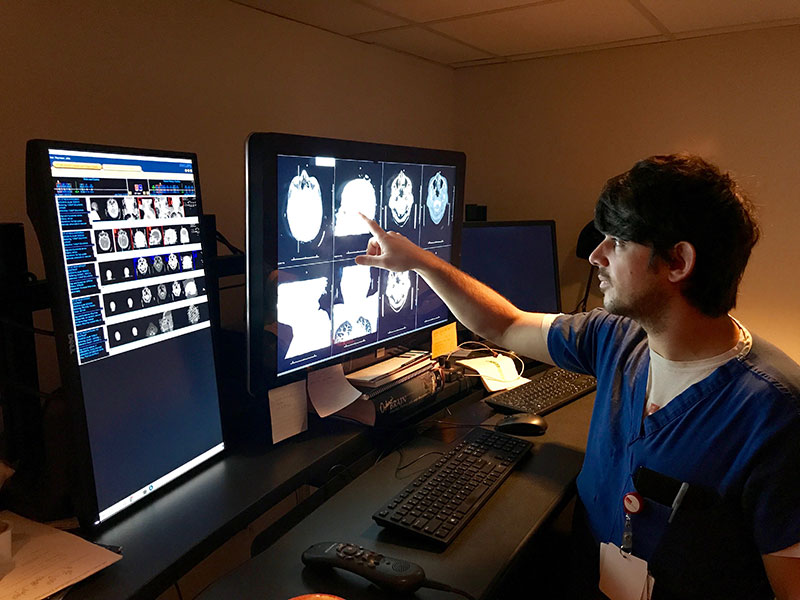
Although medical imaging technology is crucial to the timely diagnosis and management of many conditions, UTMB radiologist Dr. John Heymann admits: The volume of imaging tests has gotten out of hand.
“I don’t think anyone is denying that this is a problem nationwide,” he said. “The number of CTs, MRIs and other imaging studies has sky-rocketed over the last few decades—and that’s not necessarily a good thing.”
In fact, an estimated 20 percent to 50 percent of imaging is considered unnecessary—a costly problem which puts patient safety at risk. Heymann, who is leading UTMB’s Imaging Stewardship team along with his colleague, Dr. Gary Horn, is on a mission to ensure imaging is used as an evidence-based tool to help with diagnosis—not just as a “shotgun approach.”
“We need to make sure we are doing the correct study at the correct time for the correct person,” said Horn. “Ordering imaging tests has become so easy to do, but some of these studies do have risks. There’s radiation involved and it may detect ‘abnormal’ findings, which could lead to unnecessary procedures or workups.”
One of the first areas the stewardship team is focusing on is imaging for lower back pain. It’s one of the most common reasons people seek emergency care; however, unless the patient has any red flags such as fever, weight loss or neurological deficits, imaging for lower back pain is usually unnecessary. Oftentimes, lower back pain may resolve itself or can be treated with over-the-counter medications and through physical therapy, massage or other forms of care.
“In fact, if a patient undergoes an imaging test unnecessarily and reads a report that describes some pathology which may not even be responsible for their symptoms, we may have ‘created’ a chronic low back pain patient by virtue of putting it in their head that something is wrong with them,” said Heymann.
The team will be tracking when and how imaging is used for back pain and provide targeted education to clinicians on imaging guidelines established by the American College of Radiology. The education is important for physicians to pass on to patients as well, because some patients insist on having certain types of imaging tests.
“Especially with low back pain, patients may come in and say they want an MRI,” said Heymann. “The physician may know this is not appropriate and that they should try more conservative measures such as six weeks of PT. But, if the patient demands an MRI, many doctors will yield to patients’ wishes. So education for physicians and patients will be a big part of this.”
In addition to back pain, the team will focus on the appropriate use of imaging for different types of abdominal pain, as well as ways to reduce the use of chest CT studies for patients with a low probability of pulmonary embolism (blood clot in the lungs).
To help physicians decide whether or not a certain test is appropriate, “ACR Select” will soon be implemented into UTMB’s Epic electronic medical record. The platform provides evidence-based decision support for the appropriate utilization of all medical imaging procedures.
“It will require clinicians to note what the patient’s problem is and then it will give you a list of imaging procedures and how appropriate or inappropriate they are,” said Horn. “A green light will pop up for something that is appropriate, a yellow light for what may be appropriate and a red light for stuff you shouldn’t do. It also provides guidance as to what should be done for certain conditions.”
Heymann and Horn agree that it will be a culture change, but it’s the right thing to do.
“I get it—adding an additional step may be a hassle for providers, but the reality is, maybe we should go through a little bit of a hassle to do what is appropriate for our patients,” said Heymann. “This will improve the overall care of the patient and the value the patient and payer receive for the health care dollars spent.”
Horn said whenever there are big changes, it will take time to adapt, but he’s encouraged to see people already getting behind the initiative and being responsive to suggestions.
“Nobody wants to do the wrong thing; they want to do the right thing—they just might need some education and direction,” said Horn. “We are hopeful with some of the new tools we now have that we will make some real headway with this over the next year.”
Other members of the Imaging Stewardship team include Dr. Alok Dabi, Dr. John Hagedorn, Dr. Robert Kaale, Dr. Leah Low, Dr. Rex McCallum, Dr. Angelica Robinson, Dr. Stephen Williams, Winston Chan, Morgan McClure and Mary Feldhusen. For more information about UTMB’s efforts to become a high-value practicing organization, visit intranet.utmb.edu/best-care.